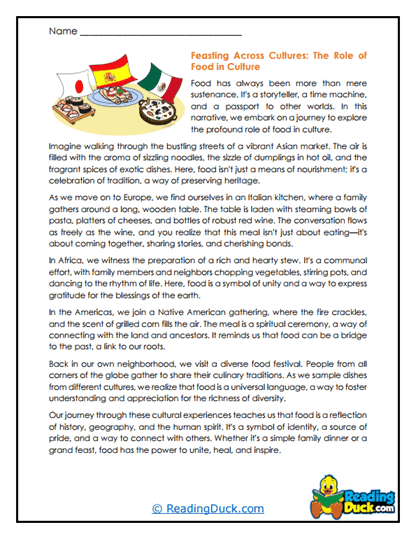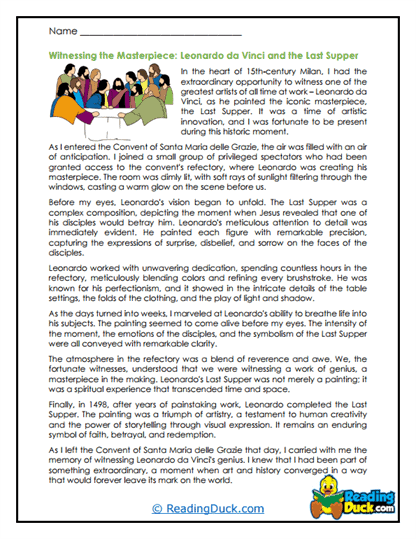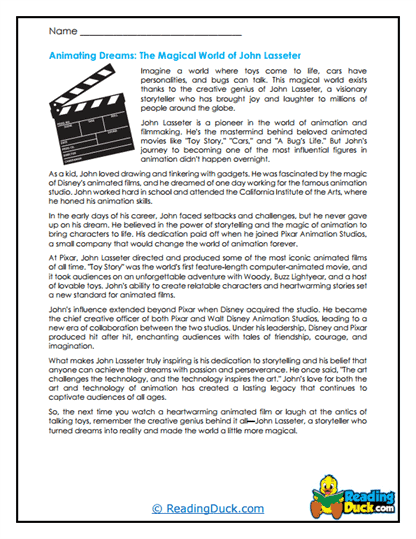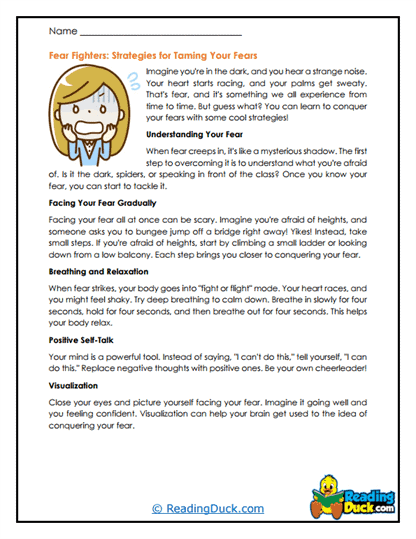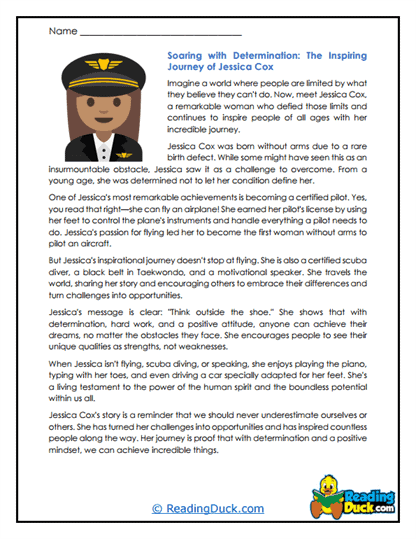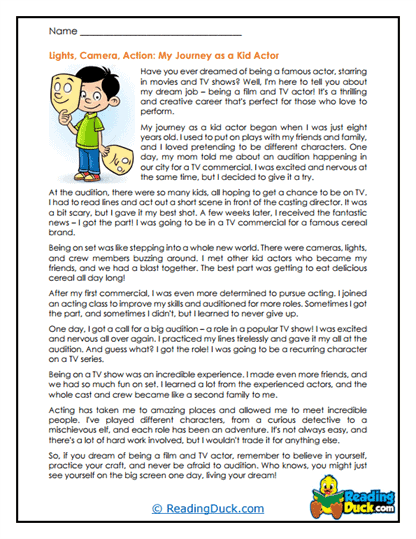Narrative Nonfiction Worksheets
About Our Narrative Nonfiction Worksheets
Our Narrative Nonfiction Worksheets offer an engaging and interactive approach to exploring this rich genre of nonfiction. Each worksheet set features a narrative nonfiction reading passage carefully chosen to illustrate real-world events, experiences, or topics through a storytelling lens. Accompanying these passages are a variety of questions, including multiple-choice, short answer, and open-ended response prompts. These worksheets are specifically designed to enhance students' reading comprehension and critical thinking skills while encouraging a deeper understanding of real-life topics.
Available in PDF format, our worksheets are simple to view, download, and print, making them versatile for both classroom use and independent study. With a downloadable answer key included for each worksheet, educators can efficiently grade student responses and provide meaningful feedback. Whether used as a teaching tool, homework assignment, or test prep, these worksheets offer a powerful way to engage with nonfiction material in a narrative context.
What is Narrative Nonfiction?
Narrative nonfiction is a genre of nonfiction that uses literary techniques typically found in fiction, such as character development, plot structure, and descriptive language, to tell factual stories. Unlike traditional nonfiction, which focuses primarily on facts and information, narrative nonfiction weaves those facts into a compelling story, making the information more relatable and engaging for readers.
This genre often centers on real-life events, historical figures, or scientific discoveries, but is written with the depth and flair of fiction, allowing readers to emotionally connect with the material. The key themes of narrative nonfiction include truth, authenticity, personal experiences, and historical accuracy, but they are presented in a way that makes the reader feel as if they are reading a novel. This genre is essential to nonfiction because it helps students explore complex topics in a way that is both intellectually stimulating and emotionally resonant.
In education, narrative nonfiction serves as an excellent tool for helping students dive deeper into real-world issues and develop a greater understanding of personal growth, societal challenges, or specific fields of study. By blending factual accuracy with storytelling, this genre not only makes learning more enjoyable but also improves retention of the material. Students are more likely to remember information when it is presented in a narrative format that engages both their cognitive and emotional faculties.
Developing Essential Skills Through Narrative Nonfiction
Our Narrative Nonfiction Worksheets are designed to enhance students' comprehension and analytical abilities by focusing on key genre-specific skills. Whether students are reading about a historical event, a personal memoir, or a real-world scientific breakthrough, these worksheets foster a variety of essential skills:
- Reading comprehension: The worksheets encourage students to fully grasp the narrative, identifying the main ideas, key details, and underlying themes within the nonfiction passage.
- Critical thinking: By answering short answer questions and open-ended response prompts, students are challenged to think beyond the text, drawing connections between the narrative and broader real-world concepts.
- Creative expression: Through open-ended questions, students are encouraged to reflect on the material, form opinions, and even create their own narrative interpretations of the events described.
For example, students might read about a pivotal moment in history and be asked to imagine how they would have responded in that situation, blending factual analysis with creative thinking. Multiple-choice questions help test factual recall and comprehension, while short answer questions delve into the more analytical aspects of the text, asking students to interpret symbols, identify narrative techniques, or explain character motivations.
Supporting English Language Learners (ELL) with Narrative Nonfiction
The Narrative Nonfiction Worksheets are an excellent resource for English Language Learners (ELL), offering accessible language and contextual support for vocabulary development. Narrative nonfiction is inherently engaging, and its storytelling nature helps ELL students connect with the text more easily, as they can follow the narrative flow while learning new vocabulary and concepts.
Here’s how these worksheets support ELL students:
- Vocabulary enhancement: Narrative nonfiction often introduces students to genre-specific terms, historical context, or field-specific language. The worksheets encourage vocabulary building by presenting new words in meaningful contexts and providing opportunities for students to explore these terms further.
- Scaffolding comprehension: The worksheet questions are designed to break down complex ideas into manageable pieces, ensuring that ELL students can grasp the text’s meaning while practicing their language skills. Teachers can offer additional supports, such as glossaries or pre-reading activities, to assist with understanding.
- Encouraging storytelling: By engaging with real-life stories, ELL students can practice both reading and writing skills in an accessible format. The narrative nature of the text helps them connect more personally with the material, improving their comprehension and retention.
The downloadable answer key allows teachers to provide swift and tailored feedback, helping ELL students improve in specific areas where they might need more practice.
Connecting Narrative Nonfiction Across Disciplines
One of the standout benefits of narrative nonfiction is its ability to bridge multiple academic disciplines, making these worksheets a powerful tool for cross-disciplinary learning. Because narrative nonfiction covers real-world topics through storytelling, it easily connects to subjects such as history, science, and social studies, offering students a holistic learning experience.
- History: Students can read narrative nonfiction accounts of historical events or biographies of significant figures, providing them with a deeper emotional and intellectual connection to the past. This can make history more relatable and engaging as students see history unfold through the eyes of individuals who lived it.
- Science: Narrative nonfiction can cover scientific discoveries or environmental issues, using storytelling to explain complex concepts in a way that is both accessible and compelling. Students can engage with real-world problems through narratives that make science feel more personal and less abstract.
- Social studies: The genre’s exploration of societal issues, cultural diversity, and global challenges makes it an ideal companion for social studies. By reading about real-world events or movements, students gain a better understanding of societal dynamics and how individuals contribute to change.
These worksheets help students draw connections between different subjects, making learning a multi-dimensional experience that encourages a deeper understanding of both the material and its relevance to the world around them.
Integrating Narrative Nonfiction Worksheets into Literacy Programs
Our Narrative Nonfiction Worksheets are an invaluable addition to any literacy program, helping students develop stronger reading and writing skills through their engagement with nonfiction texts. Narrative nonfiction requires students to analyze both factual content and literary elements, creating a unique opportunity to sharpen their ability to critically read and thoughtfully write about nonfiction texts.
By integrating these worksheets into literacy programs, educators can:
- Enhance critical reading skills: Students are taught to look for structure, tone, and the use of narrative techniques that shape the story. The worksheets guide them to consider how nonfiction writers use elements like character development, plot, and voice to bring real events to life.
- Improve written responses: Open-ended response questions require students to construct well-formed responses that are based on textual evidence and their interpretations. This helps build their ability to argue, analyze, and synthesize information from a variety of nonfiction sources.
- Increase engagement with nonfiction: Narrative nonfiction is often more engaging than other forms of nonfiction because it tells a story. By using these worksheets, teachers can spark students' interest in nonfiction genres, which is particularly valuable for reluctant readers or those who prefer fictional texts.
By aligning the worksheets with broader literacy goals, students will not only improve their comprehension and writing skills but also gain confidence in tackling nonfiction texts across different subjects.
Inspiring Personal Reflection and Critical Analysis
A key element of narrative nonfiction is its capacity to inspire both personal reflection and critical analysis. Our Narrative Nonfiction Worksheets are carefully designed to include questions that encourage students to think deeply about the material, form their own interpretations, and connect the stories they read to their own lives.
- Fostering personal connections: The open-ended questions within the worksheets prompt students to reflect on their own experiences and how they relate to the narrative. For example, after reading about someone overcoming adversity, students might be asked to reflect on a challenge they have faced and how they overcame it.
- Encouraging independent thought: Students are encouraged to form their own opinions about the text and its broader significance, helping them develop their capacity for independent thinking and analytical skills.
- Building empathy and insight: Through narrative nonfiction, students gain insight into the lives and struggles of others, encouraging empathy and a broader understanding of different perspectives.
These reflective exercises are designed to help students connect with the text on a deeper level, making the content not only educational but also personally meaningful.
Conclusion
Our Narrative Nonfiction Worksheets offer an engaging and comprehensive tool for exploring one of the most captivating nonfiction genres. By blending factual information with storytelling, these worksheets enable students to enhance their reading comprehension, critical thinking, and creative expression, while also fostering cross-disciplinary learning.
Adaptable for English Language Learners and perfect for integrating into broader literacy programs, the worksheets provide a powerful way to engage students with real-world topics in a narrative format. The reflective and opinion-based questions further deepen students' understanding, making the material more relatable, thought-provoking, and personally significant.
Whether used as part of a classroom activity or individual study, these worksheets offer a valuable resource for teaching narrative nonfiction, helping students become more confident, skilled, and reflective readers and writers.

